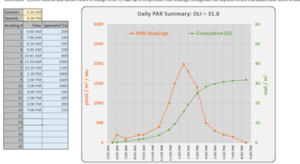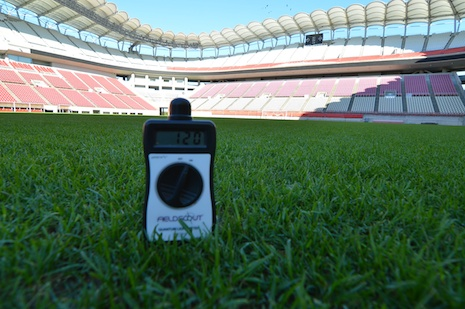As the infrastructure war continues to wage on, athletic complexes and stadiums are continually becoming more luxurious, enclosed, and yes, even taller. While these structural advancements significantly improve the fan experience (especially if your team comes out victorious), these new state-of-the-art complexes can leave sports turf managers with significant migraines. These migraines are not caused by being out in the sun too long but the complete opposite—the lack of available sunlight in these bigger and better venues can wreak havoc on turfgrass plant health.
Turfgrasses require sunlight to catalyze the photosynthetic reaction to create carbohydrates for growth and survival. This type of light is termed photosynthetically active radiation (PAR) and has wavelengths between 400-700 nm, encompassing almost the entire visible light spectrum (380-750 nm). Regardless of any cultural practices we may do to increase plant growth, if there is not enough PAR light to complete the photosynthetic process, the turf is going decline in quality. For most turf managers outside of sports turf, trees and topography can be the main sources of shaded environments. But for sports turf managers, infrastructure around the playing surface is what deprives the turfgrass of essential sunlight. It is imperative that we know precisely how much PAR light is available at our facility so we can tailor our agronomic decisions to deliver a quality and safe playing surface.
Before the 2000s most turfgrass shade research focused on determining what percent of continual shade would result in acceptable or unacceptable quality turfgrass. While this information is valuable in advancing the scientific knowledge of turf response to shade, continual shade throughout the day rarely exists in nature, and is not common in most athletic complex scenarios. More often than not, portions of the playing surface will experience varying degrees of shade at different times throughout the day. Therefore, shade issues at every athletic field differ.
In order to account for the varying light availability at each location we need a standardized method to calculate exactly how much light is available at these problems spots on the field. That is where the daily light integral comes in. The daily light integral (DLI) is the total amount of PAR light delivered to the turfgrass surface over an entire day. PAR light is reported as a quantity of light energy (µmol of PAR) and DLI is reported as a larger quantity (mol of PAR/area/day). The DLI takes into account all changes in shade levels throughout the day and leaves us with one important number of our light availability at a certain cite. It is essential to make this measurement on several days throughout the year to fully account for the variation in light conditions across seasons at that particular site.
Turfgrass researchers have been using the DLI measurement as the new standard in determining minimum light requirements for turfgrasses. Previous research has determined minimum DLI thresholds for many grasses under varying management regimes. Most established thresholds are for warm-season grasses due to their relative intolerance for shade compared to cool-season grasses. While these minimum DLI requirements may not fit your exact turfgrass type or management regime (i.e. mowing height), an important rule of thumb will be that the necessary DLI for a certain turfgrass will get higher as mowing height is lowered and vice versa.
A study in Florida reported that for each 1 mm mowing height increase; the minimum DLI requirement was lowered by 2.0 mol of PAR/area/day for ‘Champion’ and ‘TifEagle’ ultradwarf bermudagrass. Additionally, using the growth regulator trinexapac-ethyl has improved turf quality in shaded areas and has been shown to lower the minimum DLI by over 6.0 mol of PAR/area/day DLI on a ‘TifEagle’ putting green.
Turfgrass managers can calculate the DLI at their facilities and then compare their results to minimum DLI requirements established by researchers to help guide agronomic decisions. Determining the DLI at your site is actually a very easy calculation that just requires a few measurements per day of light using a PAR light meter. [We used a FieldScout Quantum Light Meter.] The meter will give you an instant measurement of PAR (µmol of PAR/area/second). Drs. Mike Richardson and Doug Karcher at the University of Arkansas (my master’s thesis advisors) have developed a handy DLI calculator freely available for download (https://github.com/trr33/DLICalculator/blob/master/DLICalculator.xlsx). You plug in the PAR numbers that you measure over the course of the day, and the spreadsheet will tell you what the DLI is and a produce a graph that illustrates the distribution of light throughout the day at your site.
As part of my master’s research at Arkansas we looked at four turfgrass types at three golf courses mowed at a fairway height where shade was an issue. We set up sensors at different levels of shade stress and connected them to a data logger that measured PAR every 15 minutes for 6 days to calculate the DLI at each sensor location. By looking at the break-even point of turfgrass quality at each site, we were able to determine what the site-specific minimum DLI was at that location. We also took each one of these grasses and put them under varying levels of shade stress (22, 40, 60, and 90% shade) in a research setting for two growing seasons . What we found is the minimum DLI obtained from the 6-day evaluation period in the golf course setting accurately matched the minimum DLI for 2 of the 4 grasses in the two-year research trial. We theorize that the continuous 6 day evaluation period was not a fair representation of the long term (2+ years) DLI at that location for the other two turf types and if we had spread our evaluation dates out over the season, we would have matched our minimum DLI for those grasses obtained in the research setting.
. What we found is the minimum DLI obtained from the 6-day evaluation period in the golf course setting accurately matched the minimum DLI for 2 of the 4 grasses in the two-year research trial. We theorize that the continuous 6 day evaluation period was not a fair representation of the long term (2+ years) DLI at that location for the other two turf types and if we had spread our evaluation dates out over the season, we would have matched our minimum DLI for those grasses obtained in the research setting.
It is recommended to take PAR readings to calculate DLI once per month in the growing season to get an accurate representation of the DLI at each site you wish to quantify.
Knowing the DLI at locations throughout the field provides turf managers with essential quantified data to improve their agronomic plan for the field. This could be as simple as raising mowing heights or using growth regulator in these shady spots. Alternatively, the DLI could provide data to support more expensive options such as planting a different species/cultivar in problem areas or investing in supplemental lighting (capable of providing ~1 mol of PAR per hour).
As the next generation of turfgrass management continues to lean more on data driven technology to improve playing surface quality, it is important that turf managers be able to put numbers and data to these shaded problem areas. Athletic complexes and stadiums are going to get larger and taller, but turf managers have the tools and expertise to overcome these shaded areas and bring light to where there is none.
Travis Russell is a PhD student in agronomy, Department of Plant Science, The Pennsylvania State University.


